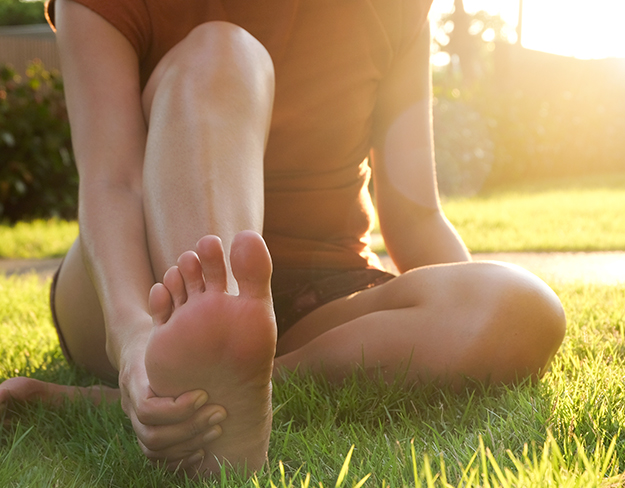

Just what is a Callosity?
A callosity is an excess collection of the outer layers of the skin. This is usually a response to repetitive high pressure on a certain area of the skin. The thickened skin on the hands of a builder or on the sole of a barefoot walker are examples of callosities. A callosity can usually be found on the heel of the foot, ball of the foot, or on the big toe. Callosities are usually painless.
Calluses are slightly different. They are broad areas of thickened skin. Calluses occur on the sole, in the middle of the ball of the foot. In this instance, it is called a plantar callus

Callosity vs Plantar Callus on the foot
What causes Callosities?
Callosities form due to too much pressure on a specific area of the foot over a period of time. High-heeled shoes and ill-fitting shoes commonly cause callosities to form. Other causes include foot abnormalities e.g. flat feet or arched feet, obesity, loss of fatty tissue on the bottom of the foot, or an abnormality in one’s gait.
Plantar calluses occur due to abnormal weight bearing from the head of the 2nd and 3rd metatarsals. Some people have long 2nd and 3rd metatarsals as compared to the 1st metatarsal. This then allows more weight to go through the heads of the 2nd and 3rd metartarsals. These plantar calluses in the middle of the ball of the foot can be painful when walking or bearing weight. Pain in the head of the metarsals is called metatarsalgia. Sometimes metatarsalgia and plantar calluses may occur following bunion surgery[2].

How is a callosity treated?
Callosities are not serious and usually do not require medical attention. A few simple measures to help treat callosities include:
- Moisturizing the feet to keep the skin soft
- Soaking the feet in warm soapy water to soften the skin
- Using a foot file or pumice stone to remove hard skin
- Wearing comfortable, wide shoes
- Supporting the foot with soft arch support and a metatarsal pad
- Wearing thick socks
Plantar calluses can be treated by using a metatarsal pad or an orthotic with a metatarsal pad. The metatarsal pad helps transfer increased forefoot pressure to a different area of the foot.
Sometimes the excess thickened skin from a plantar callus can be shaved off with a surgical knife. Research by Landorf and workers showed that surgical removal is no better than a sham procedure. This may suggest that surgical removal is not an advantage.
However, in patients with diabetes, plantar callus increases the risk of ulceration. Surgically trimming the callus has been shown to be effective. Trimming of the callus should only be performed by trained professionals.
Off-loading pressure from the foot and the addition of soft orthotics can reduce the chance of a callus developing.
more recommended stories
 Safer Allogeneic Stem Cell Transplants with Treg Therapy
Safer Allogeneic Stem Cell Transplants with Treg TherapyA new preclinical study from the.
 Autoimmune Disorders: ADA2 as a Therapeutic Target
Autoimmune Disorders: ADA2 as a Therapeutic TargetAdenosine deaminase 2 (ADA2) has emerged.
 Kaempferol: A Breakthrough in Allergy Management
Kaempferol: A Breakthrough in Allergy ManagementKaempferol, a dietary flavonoid found in.
 Early Milk Cereal Drinks May Spur Infant Weight Gain
Early Milk Cereal Drinks May Spur Infant Weight GainNew research published in Acta Paediatrica.
 TaVNS: A Breakthrough for Chronic Insomnia Treatment
TaVNS: A Breakthrough for Chronic Insomnia TreatmentA recent study conducted by the.
 First-of-Its-Kind Gene-Edited Pig Kidney: Towana’s New Life
First-of-Its-Kind Gene-Edited Pig Kidney: Towana’s New LifeSurgeons at NYU Langone Health have.
 Just-in-Time Training Improves Success & Patient Safety
Just-in-Time Training Improves Success & Patient SafetyA study published in The BMJ.
 ChatGPT Excels in Medical Summaries, Lacks Field-Specific Relevance
ChatGPT Excels in Medical Summaries, Lacks Field-Specific RelevanceIn a recent study published in.
 Study finds automated decision minimizes high-risk medicine combinations in ICU patients
Study finds automated decision minimizes high-risk medicine combinations in ICU patientsA multicenter study coordinated by Amsterdam.
 Study Discovers Connection Between Omicron Infection and Brain Structure Changes in Men
Study Discovers Connection Between Omicron Infection and Brain Structure Changes in MenA recent study in the JAMA.

Leave a Comment